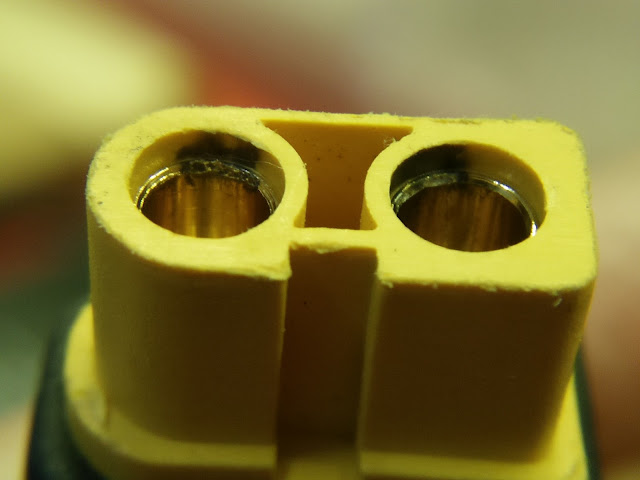plug your charger into the wall first.
In case that's not obvious, plug the charger into the wall, then into the scooter.
Why?
This is a closeup of the XT60 plug my scooter has for charging. You can see the evidence of powerful sparks arcing across between the charger and the battery in the burns and pitting happening on my plug:
And
So "why is it so".
Its simple really, its potential difference (you know what we measure when we measure voltage).
And
So "why is it so".
Its simple really, its potential difference (you know what we measure when we measure voltage).
If no difference exists then no current (electricity) flows, if a big potential difference exists then a big current flows, even momentarily this does damage like above.
Heck this is what spot welding does (and how it works).
Where is the potential difference? Well its between your battery and the unpowered charger. If your battery is (say) 46V (very discharged down from its normal 52V) then if the charger is off its got a potential of 0V so there is a 46V potential difference to equalise. Plug it in and POP.
This pitting will cause premature death of your charging connection plug (which in my case the terminals are gold plated for better contact, so I'm destroying that for a starter).
Why has it happened to me? Well some times I forget that I've unplugged the charger (or I've moved it between places and haven't turned it on at the wall).
Many batteries on scooters are permanently simply hard wired to the charging port, and much of the smarts of charging is in the Battery Management System (BMS). If you attempt to plug the charger in when its turned off the charger plug will be at zero volts, so there will be a potential (probably 47V) difference between the plug (and the powered down charger circuit it leads to) and to the battery terminal.
This pitting will cause premature death of your charging connection plug (which in my case the terminals are gold plated for better contact, so I'm destroying that for a starter).
Why has it happened to me? Well some times I forget that I've unplugged the charger (or I've moved it between places and haven't turned it on at the wall).
How do avoid this damage?
Many batteries on scooters are permanently simply hard wired to the charging port, and much of the smarts of charging is in the Battery Management System (BMS). If you attempt to plug the charger in when its turned off the charger plug will be at zero volts, so there will be a potential (probably 47V) difference between the plug (and the powered down charger circuit it leads to) and to the battery terminal.
This will cause exactly the damage you see above as the electrons briefly surge across to equalize the voltage.
By simply turning on your charger first you'll have it sitting at about 54~55V and even if your battery is quite run down (45V) then at most you'll have a 10V potential difference and thus very little current flow.
By simply turning on your charger first you'll have it sitting at about 54~55V and even if your battery is quite run down (45V) then at most you'll have a 10V potential difference and thus very little current flow.
Alternatively if you didn't turn your charger on first then you'll have 0V at the charger end and 45V at the battery and you'll hear the characteristic "TICK" of a spark jumping while it equalizes the potential (electrical pressure) difference.
Lastly don't "take my word for this", go get a volt meter (and if you have an electric scooter you should already have one, they cost like $10) and measure the voltage across the terminals (absolutely take care to NOT short them out, one probe must only touch one terminal). Measure your battery, and measure your charger. Polarity does not matter if you have a digital multimeter.
HTH












2 comments:
Very good point for the safety and keeping our devices healthy for long term usage.
Thanks for the review and instructions.
Cheers
Great bit of advice as this was happening to me now i know how to overcome it I'm much more happier to connect the too offending problems
Post a Comment